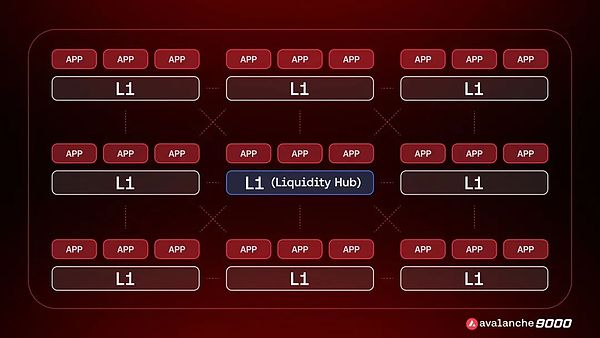
Author: Yangz, Techub News
250 million US dollars in financing to accelerate upgrades, from subnet to Avalanche9000, Avalanche Want to change something?
On the evening of December 12, Avalanche announced the completion of US$250 million in financing through locked token sales. Galaxy Digital, Dragonfly and ParaFi Capital led the investment, and investors included SkyBridge, SCB Limited, Hivemind, Big Brain Holdings, Hypersphere, Lvna Capital, Republic Capital, Morgan Creek Digital, FinTech Collective, CMCC Global, Superscrypt, Cadenza, Chorus One and Tané Labs are among more than 40 investment companies, and the funds raised will be used to promote an upgrade called "Avalanche9000".
To be honest, the author has not learned about Avalanche9000 before. Compared with the popular Memecoin, the progress of many established public chains has been ignored in this bull market. As early as early September, Avalanche announced the launch of the Avalanche9000 upgrade (or Etna upgrade), which it regarded as "the largest upgrade" since its launch. To put it simply, Avalanche hopes to change its original expansion form "subnet" through Avalanche9000 and build it into Avalanche L1. According to Avalanche, Avalanche9000 will allow the new Avalanche L1 to customize staking, gas tokens, governance, etc. while retaining the advantages of fast subnet finalization times and high throughput. But specifically, how will this upgrade be achieved?
As one of the original "Ethereum killers", Avalanche will open the "Subnet Road" in 2022, allowing various applications to create their own application chains. However, to become a subnet verifier, you need to verify the Avalanche main network (Primary Network) at the same time, including the contract chain (C-Chain), platform chain (P-Chain) and transaction chain (X-Chain). This equates to a validator having to allocate at least 8 AWS vCPUs, 16 GB RAM, and 1 TB storage space for network verification, in addition to a minimum stake of 2,000 AVAX.
Initially, this requirement may not be too high, but as AVAX appreciates (AVAX price is around $52 at the time of writing), the overall operating cost will Getting higher and higher (the minimum staking requirement can be lowered, but frequent changes may not be a consideration for Avalanche). In the long run, such a high barrier to entry will affect the adoption of the Avalanche ecosystem.
Therefore, the Avalanche Foundation launched proposal ACP-77 in April, aiming to completely reform the creation and management of subnets and give subnet creators greater access to flexibility.
Under the proposal, Avalanche L1 validators will no longer need to simultaneously validate the main network. They simply synchronize with P-Chain, which tracks changes to its own set of Avalanche L1 validators and handles cross-L1 communication via AWM. Additionally, Avalanche L1 can decide and implement its own validation rules and staking requirements, and P-Chain will no longer support staking reward distribution for Avalanche L1. In other words, the sovereignty of Avalanche L1 returns from P-Chain to L1 itself.
On the other hand, the proposal plans to transform P-Chain’s charging mechanism from a fixed charge per transaction to a dynamic charge that is more in line with the user-pays principle, thereby Ensure Avalanche's long-term economic sustainability after removing the 2000 AVAX staking requirement. Specifically, the dynamic charging mechanism is related to multiple factors such as the total number of Avalanche L1 validators registered on P-Chain. Fees will be adjusted based on network usage and will increase when the total number of Avalanche L1 validators exceeds target usage and vice versa.
In addition to the proposals in ACP-77, other implementation foundations of Avalanche9000 include two major interoperability protocols: Inter-Chain Token Transfer (ICTT) and Inter-Chain Messaging (ICM).
ICTT is a set of cross-chainCommunication protocol Teleporter and Avalanche Warp Messaging technology, smart contracts deployed in multiple subnets, allow users to transfer tokens between subnets. Each token transferr consists of a "home" contract and at least one (possibly multiple) "remote" contracts. The "main" contract is located in the subnet where the assets are to be transferred. "Remote" contracts exist on other subnets.
ICM is designed to enable seamless communication between C-Chain and new and existing Avalanche L1. As soon as a new L1 is deployed via Avalanche, it is immediately supported and ready to interact with other L1s. With ICM, developers can send messages from one Avlanche L1 to another by simply calling sendCrossChainMessage on the TeleporterMessenger contract. (Note: The Github technical documents related to ICM have not yet been released. Interested students can refer to the relevant courses of Avalanche College.)
From September 3 to now, only more than three months have passed, but the progress of Avalanche9000 is not slow. In the month of the official announcement, the Avalanche Foundation announced the launch of two incentive programs, namely Bounty9000 with a maximum reward of $9,000 and Retro9000, a retroactive incentive program of $40 million, designed to reward developers who develop L1 and related tools on Avalanche. On November 26, Avalanche9000 was upgraded and launched on the Fuji test network, and the latest expected time for the main network to be launched is December 16.
Avalanche said that the Avalanche9000 upgrade will reduce the deployment cost of Avalanche L1 by 99.9% and reduce transaction costs on existing C-Chain by 25 times. More than 500 L1s are currently under development, covering areas such as tokenization of real-world assets (RWA), loyalty and rewards, games, payments and institutional projects.
Avalanche9000 will undoubtedly make a significant mark on Avalanche's expansion path. However, as of the current marketIn an environment where market sentiment is more inclined to chase high-risk assets without a clear technical foundation, can such technological advancements bring Avalanche back to investors' attention? In fact, not only Avalanche, but also NEAR's layout on AI, Polkadot's 2.0 plan, and the TradFi wave on Aptos, etc., have all been submerged under the torrent of Memecoin. Memecoin’s “instant burst” attribute has its own market logic, and various technological advancements often take longer to settle and verify.










